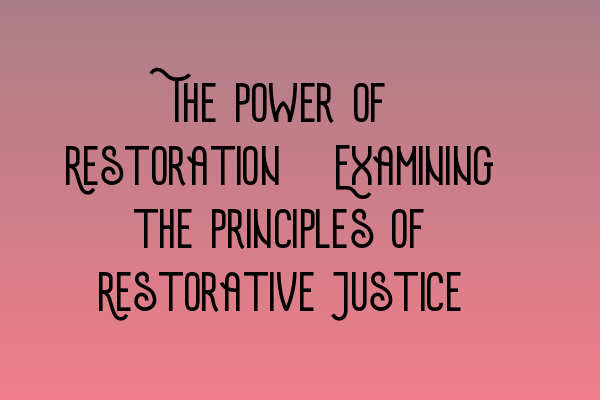The Power of Restoration: Examining the Principles of Restorative Justice
Restorative justice is a philosophy that focuses on repairing the harm caused by a criminal offense through a cooperative process involving the victim, offender, and community. It aims to address the underlying causes of crime and promote healing, accountability, and reintegration. In this article, we will delve into the transformative potential of restorative justice and explore its principles in depth.
1. Victim-Offender Dialogue
A fundamental principle of restorative justice is the victim-offender dialogue, where both parties come together in a safe and structured environment to discuss the impact of the offense. This dialogue humanizes the offender and allows the victim to express their emotions, seek answers, and ultimately find closure. By actively involving the victim in the process, restorative justice empowers them and helps restore their sense of dignity and control.
2. Community Involvement
Restorative justice recognizes that crime affects not only the victim and offender but also the wider community. Involving the community in the restorative process encourages understanding, empathy, and collective responsibility. Community members can participate as supporters, facilitators, mediators, or advisory panel members. This collaborative approach builds stronger communities and promotes a sense of ownership in addressing crime.
3. Accountability and Responsibility
Rather than focusing solely on punitive measures, restorative justice emphasizes accountability and responsibility. Offenders are encouraged to take responsibility for their actions, acknowledge the harm caused, and actively work towards making amends. Through meaningful restitution, community service, or educational programs, offenders can demonstrate their commitment to repair the harm they have caused and reintegrate into society as responsible citizens.
4. Healing and Transformation
Restorative justice recognizes that healing is an essential aspect of the justice process. Victims, offenders, and even the community can experience healing through open dialogue, emotional support, and the opportunity for personal growth and transformation. By addressing the root causes of crime, restorative justice seeks to break the cycle of reoffending and promote positive change in individuals and communities.
5. Benefits of Restorative Justice
Restorative justice offers several benefits compared to traditional punitive approaches. It promotes victim satisfaction, reduces the likelihood of reoffending, and improves community safety. Additionally, it is cost-effective and can alleviate the burden on the criminal justice system. By fostering empathy and personal accountability, restorative justice has the potential to create a more just and inclusive society.
In conclusion, restorative justice offers a powerful alternative to punitive approaches in the criminal justice system. By prioritizing healing, accountability, and community involvement, it addresses the needs of victims, empowers offenders to make amends, and fosters stronger and safer communities. To learn more about restorative justice and other legal topics, explore our related articles:
SQE 1 Practice Exam Questions,
SQE 1 Practice Mocks FLK1 FLK2,
SQE 2 Preparation Courses,
SQE 1 Preparation Courses, and
SRA SQE Exam Dates.
